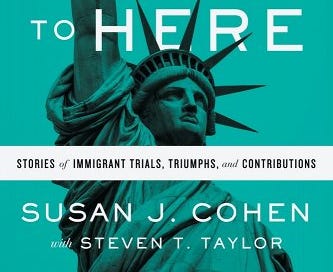Full disclosure: I know this book’s co-author, Steven T. Taylor, whom I met several years ago while interviewing his son. We later crossed paths again when his wife wrote the script for a middle school play that my son acted in. So it wasn’t a total surprise when he sent me a copy of this book. But I didn’t know it existed until then.
***
As immigration experiences go, my parents’ was so uneventful that as a teen who was becoming aware of social and political injustices, I was sometimes embarrassed by what an easy time they’d had. They didn’t walk for weeks to cross a border. They didn’t deal for months with ruthless smugglers. They didn’t spend years in a refugee camp. They simply boarded a plane one day and flew to the United States. If they’d experienced so much as a rude comment from a Customs agent, they never mentioned it. Where was the drama? I didn’t appreciate that they hadn’t had to suffer. I yearned for a story.
***
The 11 people we meet in the book “Journeys From There to Here: Stories of Immigrant Trials, Triumphs, and Contributions,” published in 2021, come from throughout the world, and their life stories reflect a broad range of circumstances and experiences. But they have one crucial experience in common: They’ve all been clients of Susan J. Cohen, a nationally respected immigration lawyer with the Mintz law firm.
In telling their stories, Cohen and her co-author, Steven T. Taylor, give readers a thorough look at the U.S. immigration system, in which it seems open hearts, closed minds, personal gifts and outright luck all play equal roles.
Take the story of Peng, a young man from rural China who turned to smugglers to spirit him out of the country after he and his wife incurred the wrath of their government by violating its one-child policy. Hoping to find refuge with an uncle in the U.S., he was detained in Boston, then sent out on the streets to fend for himself without any knowledge of English or any familiarity with cities, much to Cohen’s dismay.
I tried to restrain my anger.
“I specifically asked you to let me know if you were going to release him — BEFORE you released him — so that I could come and get him. And you said you would.”
“That’s not my problem, ma’am,” the officer said. “Look, you should just be happy we let him go.”
Or take the story of Jacque, a woman from the Dominican Republic who did everything the U.S. government required of her to stay in the country legally, including notifying officials each time she changed her address. By the time Cohen got Jacque’s case, her immigration file included multiple envelopes all stamped “Not deliverable” and returned to the government due to its own errors. Here’s how Cohen describes the result:
When my team went to court to make our case, the judge took one look at the filing and said he was inclined to grant the motion to terminate removal proceedings immediately. Tellingly, the government attorney didn’t raise a fuss and made no effort to oppose the motion. This, by itself, is quite rare. In the end, it was an open-and-shut case.
***
My parents’ immigration story wasn’t so simple after all. For one thing, they hadn’t come to the U.S. from a similarly democratic society, but from a repressive regime that they described in lowered voices even inside our home. For another, they’d bent the law in what I thought was a rather clever way to get their exit visas.
Then there was the almost unbelievable experience my mother had when her immigration documentation was on the verge of expiring and she dutifully went to renew it. The official she saw suggested that she apply for permanent residency instead, saying the U.S. needed more people like her. With his help, she got her green card and stayed for the rest of her life. This story seemed, and still seems, too good to be true. But if there was one trait my mother had to a fault, it was honesty.
***
The clients featured in “Journeys From There to Here” all repaid Cohen’s efforts by becoming valued members of American society. Indeed, she made the cases for several of them by petitioning for an O-1 visa, granted to “individuals with extraordinary ability or achievement.” Other clients were awarded political asylum after Cohen showed convincing evidence that they would be in direct danger if they returned to their homelands. Several have gone on to touch the lives of many others, such as the Honduran educator who has inspired numerous teachers to adopt his philosophy and methods, and the Somali banker who funds community projects internationally.
Cohen and Taylor chose their subjects well — one can’t help but root for the committed lawyer and her plucky clients. And the book closes with a call to action for those who feel moved and inspired. Meanwhile, reading it also raises the question: What about those whose cases Cohen didn’t win or who never found their way to her or other advocates like her? What tiny fraction of the stories out there do these represent?
“Journeys From There to Here” feels like an apt read this July Fourth weekend in how it gathers together the contradictory threads of this country: the mythos that we’re a nation of immigrants represented by the Statue of Liberty, the reality that we build walls and cages and mounds of red tape at the border, the welcome that we grant to individuals we come to know, the silence with which we shroud the rest. It is, in other words, a very American book.



